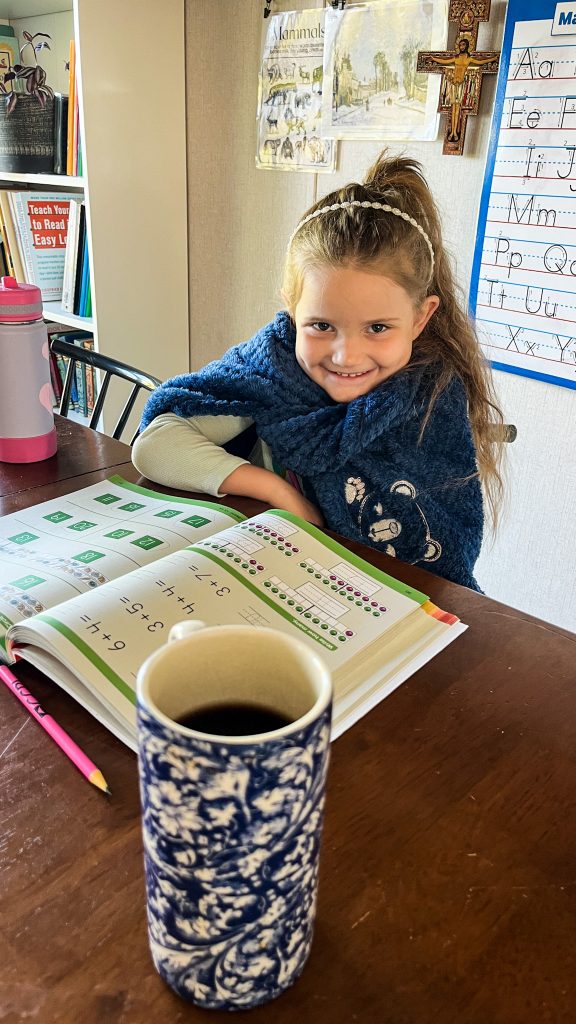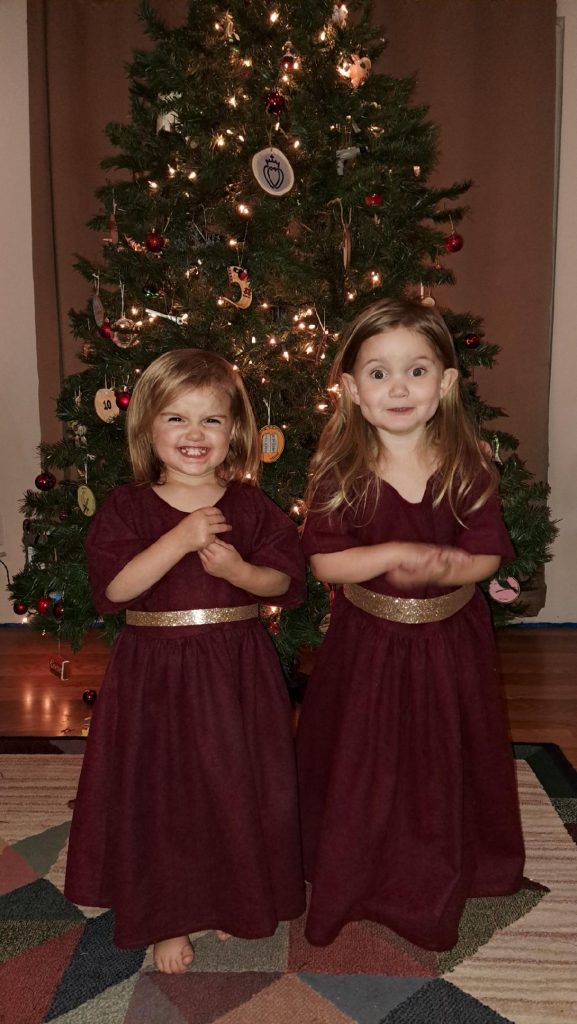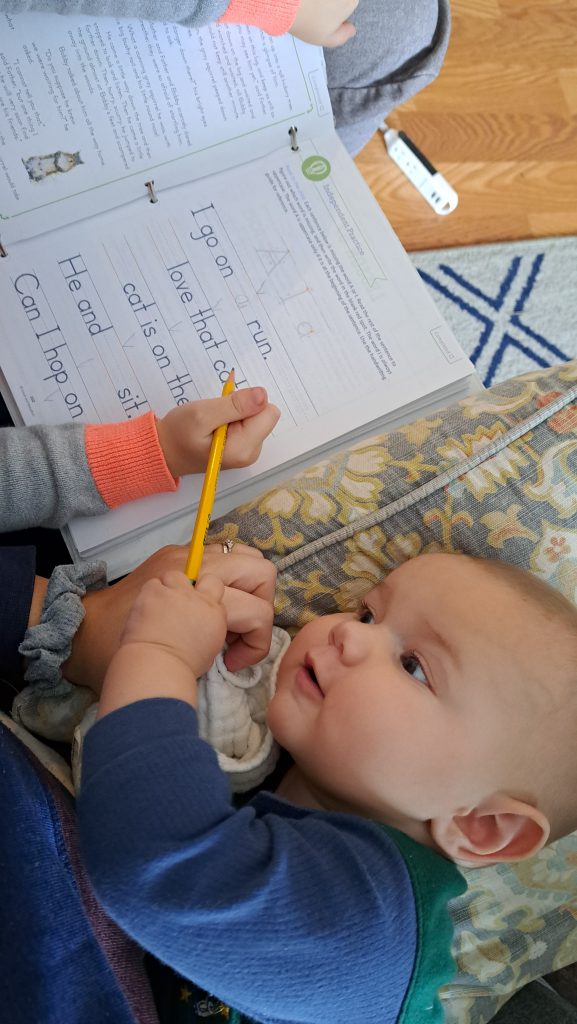We have learned so much during our first year homeschooling; about what we look for in a curriculum, how each of our children learn best, and how we want to function as a homeschooling family.

This post may contain affiliate links, which means we may receive a commission, at no extra cost to you, if you make a purchase through a link. Please see our full disclosure for further information.
First Year Homeschooling 2024-2025
Our oldest daughter started school early for kindergarten at our private Catholic school affiliated with our church. Once we decided that we would like to switch to homeschooling her, we weren’t really sure how to proceed because a lot of the methodologies that we would like to adhere to maintain that young children should simply learn through play until they’re 6 or 7 years old. Then they’re ready to formally begin “schooling.”
Since our daughter was 4 years old at the end of her kindergarten year, we wondered if we should take a year or two off from any formal education and begin when she was 6. This would give her that time to learn from play. However we didn’t want her to think that she just wasn’t smart enough to keep “doing school” and because she would then be in first grade when all her friends and peers are in third grade, we had reservations.
Ultimately we decided that for a year we would go ahead and “homeschool” and call it first grade, so that she was staying on par with her friends from kindergarten. But we chose to only work through a reading/language arts curriculum and a math curriculum. We also learn religion/catechism on the side but it is largely discussion based rather than working from a specific curriculum.
Grade Level Assessment
Even though we decided to call our first year of home school “first grade” we knew that a lot of what she had been taught in kindergarten had not been retained, and that we would have to go back if we wanted her to understand all that information. It was a little bit daunting at first to try to assess her level of knowledge across even just two topics, math and reading/ELA, and try to line that up with a specific grade of a premade curriculum.
I google searched for reading assessments but they were hard to administer because the school she went to taught the alphabet, sounds, and reading through cursive first and not through print. That was a difficult hurdle.
Math was easier to assess by far. There were still enough gaps in her math knowledge that I ultimately decided that she needed a kindergarten curricula to work through again to fill in all the gaps. I also figured that a lot of review would make it an easier experience and less daunting for our first year homeschooling.

First Grade vs Kindergarten
I poked around at a lot of kindergarten and first grade curricula. I had a lot of trepidation about buying a curricula that didn’t include some form of lesson plans, but I think that was the once-upon-a-time-public-school-teacher inside me. I wanted to be “on schedule.” But on schedule for what? I was already choosing a kindergarten curriculum for a “first grader.” So why did it matter? It shouldn’t have. I also had the notion that if I picked something simple enough that it would go faster and we could get into an actual first grade curriculum and be “caught up” with her grade level some time during the year. That too was silliness.
I ended up buying the book Teach Your Child to Read in 100 Easy Lessons, and downloading the free pdf printable versions of The Good and the Beautiful Math and ELA curricula for kindergarten. I thought that their books and illustrations looked beautiful and I hoped that that would encourage my child who had grown to associate school with unpleasantries to change her mind and enjoy it.
She did enjoy it but the reading book and the TGATB ELA were not really compatible with one another, which was a mistake. TGATB does not have a very well founded approach to learning reading, though one may have success with it if you started all the way back in their pre-preschool and preschool curricula instead of with kindergarten.
The TGATB Math curricula was good, and beautiful, but contained a lot of fluff and what felt like busy work and she didn’t enjoy that so much, despite math being her strongest and favorite subject. There was very little actual practice and more games than we cared to participate in. However we finished our “first grade” school year feeling like we had accomplished something, despite not getting through the complete book for any of these materials!
The Power of Pre-School
One of the wonderful things about homeschooling for pre school is that you can slowly introduce subjects and topics and concepts that your child doesn’t even associate with “school” but which prepare them for things like reading and math.
My second daughter who was 3 when this school year began begged and begged to “do school” with her sister. So I found fun printables and “preschool” material for her to work on alongside us. But she learned the MOST from simply listening to our discussions and lessons unfolding for first grade.
The great power of pre-school is that it sets up a child for success later. There are many things we wouldn’t consider as being school or preschool but they really do get the job done. And perhaps not surprisingly, all of these things involve being a present and open parent.
- counting things out loud as you see or use them (putting silverwear away, folding laundry, etc)
- describing things using their number and color (two blue socks, one red hat)
- articulating our words as we speak so that all the sounds can be heard (yes instead of yup or yeah, articulating “and” vs “end,” etc)
- speaking in complete sentences when modeling for them (say, “please help me.” rather than just “help!”)
- asking them clarifying questions (“do you really dislike it or are you having a hard time with it?” /”which thing happened first?”)
There are countless examples, but this gives you a little idea. Remembering to do such things when you can really is monumental in forming a framework in their minds for “school” learning to slide into when the time comes.
This is why our then-3-year-old begged to do school with us, because she already enjoyed all these thought games. And when she turned 4 in the middle of the school year, the gift she loved most was starting the Teach Your Child to Read book!

Using One Curriculum vs Piecing Together
As the school year is finished it is easy to look back and see what I like an didn’t like in the curricula we used. I definitely had an appreciation for the “open and go” format of both TGATB and the reading book. There are clear benefits to having this style of work laid out for a child and a parent embarking on a homeschooling journey. For us, we loved how direct it was and how little “other” stuff we needed.
Looking forward to choosing curricula for future years, I knew I didn’t like the reading and needed a new option. I also knew that I wasn’t too keen on TGATB, definitely not excited enough to buy their other subjects of curriculum. I continued looking for “open and go” or “all in one” style curricula where I could just buy the whole set and be done shopping. But I also knew I wanted to be sure enough about it that I’d want to keep using those some materials year after year across multiple children. I also didn’t watn to switch my oldest to a new curricula each year as I investigated new possibilities.
This led me to realize that I was going to start having to piece together things that I wanted to be part of our curricula rather than buying an all in one ready to go year by year set. For someone with exactly one year of homeschool under my belt, that was intimidating. But that became the plan!
First Year Homeschooling Pros and Cons
So our first year was a wrap. We loved the aspects of being at home, being together, self pacing, and the way our family stayed close knit and not torn in a hundred directions all the time.
We didn’t really love our curriculum choices or that we didn’t totally finish any of them. But we chose to call it a success either way. And we knew from this experience that we could do better in the future with more preparation and more research.
10/10 expereince
7/10 education
20/20 hindsight fully loaded
Second Year Homeschooling Plans
Our plans for our second year of homeschool are now for a second grader and a kindergartener. I simply couldn’t do another year of “preschool worksheets” with my 4 year old, and my 5 going on 6 year old was definitely ready to learn more than just math and reading.
My main research over the summer was into Charlotte Mason, and then more specifically I looked into “Ambleside Online.” I won’t bore you with the winding rabbit holes I went down, but I wound up piecing together my own kindergarten and second grade curricula based on or inspired by Ambleside Online Year 1.
I bought a lot of the books for AO but we’ll use them differently. Year 1 is designed for a 7 year old to begin and equates with around a first grade/advanced kindergarten, which was in some ways opposite of us entirely, having a 5 year old starting 2nd grade! But the main concept is that we will be doing individual reading and math levels for my two girls, and then the rest of our subjects are done as “read alouds” with age appropriate levels of comprehension and return narration for evaluation.
Our subjects will be:
- math
- reading/phonics (truly learning to read)
- literature (having good stories read to them)
- religion/catechism/scripture etc read aloud
- natural history/science (read alouds and nature studies)
- history/geography (read alouds and map studies)
- poetry/artist studies/composer studies
The math and reading will be daily, coupled with a spread of the other subjects sometimes daily and sometimes not. My second grader will “have to” listen to me read aloud and answer any questions I have or narrate back to me what we read about. My kindergartener must listen and can chime in but the desired comprehension isn’t quite as much. This will make it doable to tackle all these fun subjects across two grade levels, while knowing that my 2nd grader will be getting all she needs and we will be exposing the kindergartener to all sorts of great discussions.

Choosing Faith Based Curricula
I made an effort to choose faith based curricula for some things. For most subjects like math and science this wasn’t a focus for me. But I know there are some great Catholic readers out there for early readers, so I checked into those. There are also good catechism and mass instruction books, liturgical living, lives of the saints, and scripture narratives.
For our Religion subjects I chose the St. Joseph’s First Communion Catechism, the Douay Rheims Bible, and a book called A Life of Our Lord for Children. We also found a Catholic-aligned history curricula through TAN books called The Story of Civilization. For reading the Pathway readers have good values that we share, though they aren’t specifically Catholic.
Our math and science curricula are relatively objective and haven’t had anything stand out to me as problematic. We are using Kindergarten, First Grade, and Second Grade Math With Confidence, and our science books are nature field guides and such. For science we always talk about how God created all the good things in our world, so I feel that we have that covered, and we always learn through that lens.
Keeping Younger Children Happy During Homeschool

Keeping our 1 year old and 3 year old happy while the KG and 2nd grader work isn’t always easy. But by involving them a little, taking breaks to do our read aloud sessions with them on the couch, and throwing in activities like coloring, dance parties, and lots of time outside, we manage.
I also find that giving the toddlers some direct attention and one on one time in the morning after breakfast before school starts helps them to feel included. So making a magnatile fort or dressing some dolls is a great way to begin. Reading an almost-picture book (trying for less “twaddle around here”) is wonderful, and then starting with a picture study or composer study, or reading poetry and having kids repeat it is something we can all enjoy together.
Encouraging them all to play together any time there is free time helps too. I frequently hold the 1 year old on my lap while we work until he gets bored and scurries off. My 3 year old likes to disassemble and reassemble our math “10 stick” blocks. There really is something for everyone.
Now, when the time comes for these little ones to join us for school, they’ll be used to our rhythms and schedules and habits, and eager as ever to be more included.